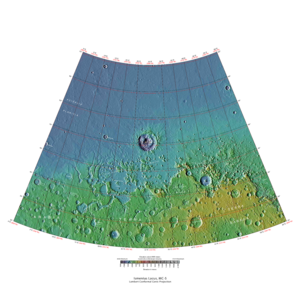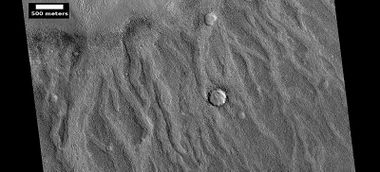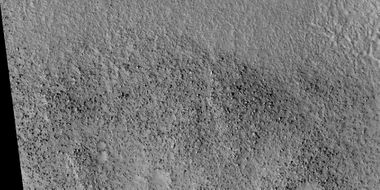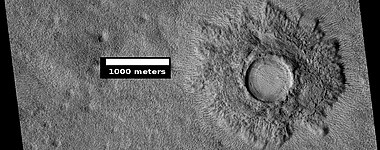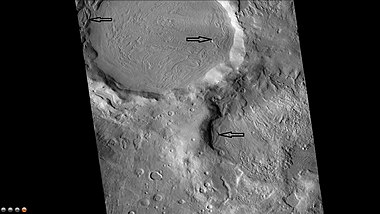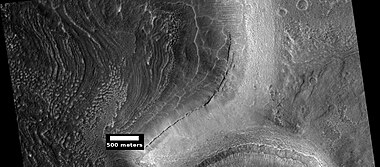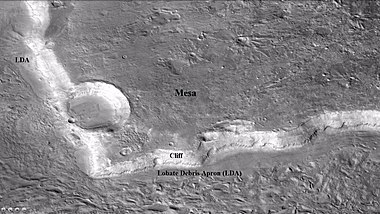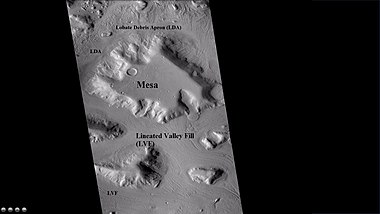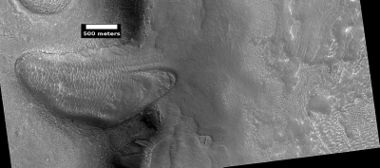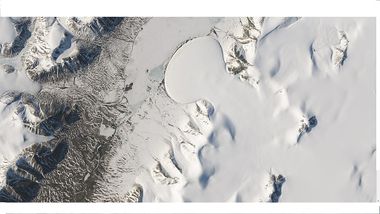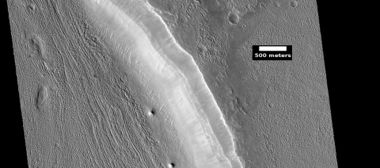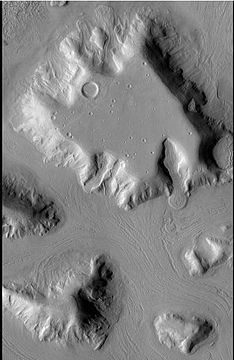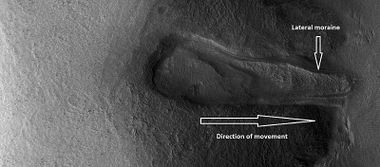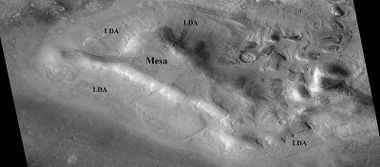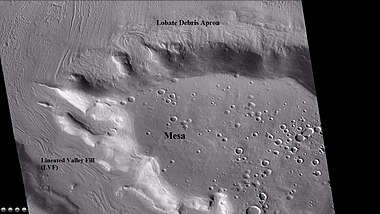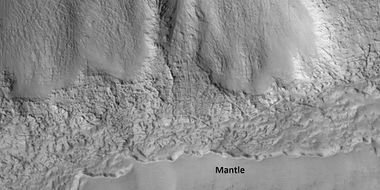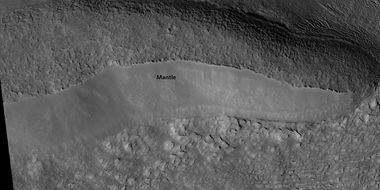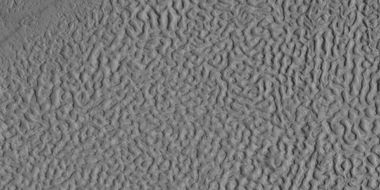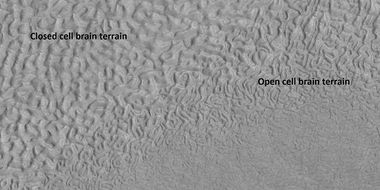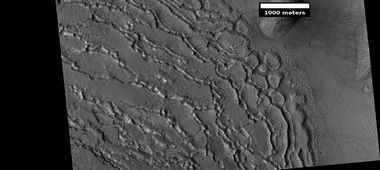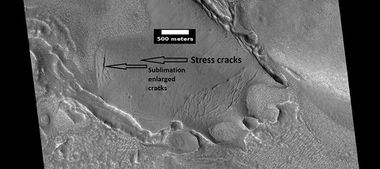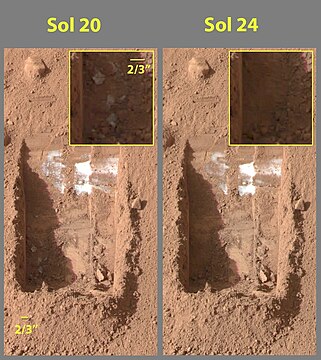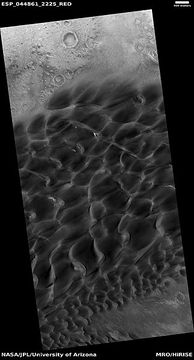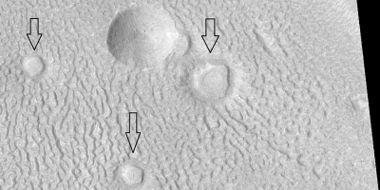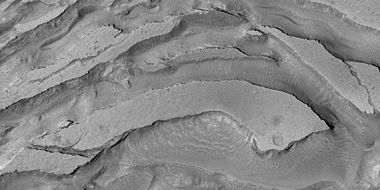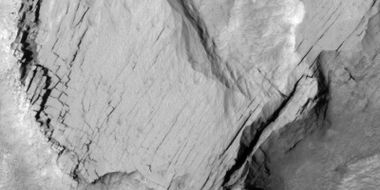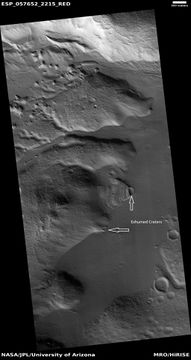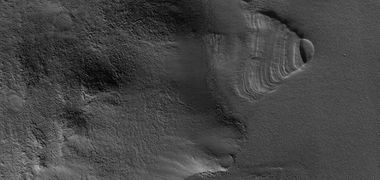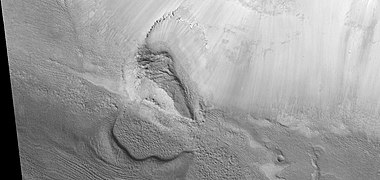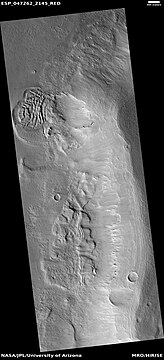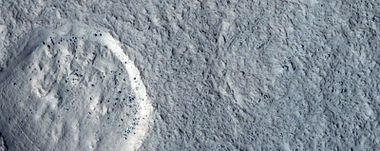Difference between revisions of "Ismenius Lacus quadrangle"
m |
m |
||
| Line 16: | Line 16: | ||
| − | This quadrangle has some of the most mysterious-looking landscapes on the planet. It truly looks like another world here. The Ismenius Lacus quadrangle contains regions called Deuteronilus Mensae and Protonilus Mensae, two places that are of special interest to scientists. They contain abundant evidence of present and past glacial activity. They also have a landscape unique to Mars, called Fretted terrain. The largest crater in the area is Lyot Crater, which contains channels probably carved by liquid water.<ref>Carter | first1 = J. | last2 = Poulet | first2 = F. | last3 = Bibring | first3 = J.-P. | last4 = Murchie | first4 = S. | year = 2010 | title = Detection of Hydrated Silicates in Crustal Outcrops in the Northern Plains of Mars | url = | journal = Science | volume = 328 | issue = 5986| pages = 1682–1686 | </ref> | + | This quadrangle has some of the most mysterious-looking landscapes on the planet. It truly looks like another world here. Strong evidence of a past ocean on Mars exists in this region and is described below. The Ismenius Lacus quadrangle contains regions called Deuteronilus Mensae and Protonilus Mensae, two places that are of special interest to scientists. They contain abundant evidence of present and past glacial activity. They also have a landscape unique to Mars, called Fretted terrain. The largest crater in the area is Lyot Crater, which contains channels probably carved by liquid water.<ref>Carter | first1 = J. | last2 = Poulet | first2 = F. | last3 = Bibring | first3 = J.-P. | last4 = Murchie | first4 = S. | year = 2010 | title = Detection of Hydrated Silicates in Crustal Outcrops in the Northern Plains of Mars | url = | journal = Science | volume = 328 | issue = 5986| pages = 1682–1686 | </ref> |
The Ismenius Lacus quadrangle is located in the northern hemisphere and covers 30° to 65° north latitude and 300° to 360° west longitude (60° to 0° east longitude). The southern and northern borders of the Ismenius Lacus quadrangle are approximately 3065 km (1,905 mi) and 1500 km wide (930 mi) respectively. The north-to-south distance is about 2050 km (1,270 mi) (a bit less than the length of Greenland).<ref>Distances calculated using NASA World Wind measuring tool. http://worldwind.arc.nasa.gov/.</ref> The Ismenius Lacus quadrangle contains parts of regions named Acidalia Planitia, Arabia Terra, Vastitas Borealis, and Terra Sabaea.<ref>http://planetarynames.wr.usgs.gov/SearchResults?target=MARS&featureType=Terra,%20terrae</ref> | The Ismenius Lacus quadrangle is located in the northern hemisphere and covers 30° to 65° north latitude and 300° to 360° west longitude (60° to 0° east longitude). The southern and northern borders of the Ismenius Lacus quadrangle are approximately 3065 km (1,905 mi) and 1500 km wide (930 mi) respectively. The north-to-south distance is about 2050 km (1,270 mi) (a bit less than the length of Greenland).<ref>Distances calculated using NASA World Wind measuring tool. http://worldwind.arc.nasa.gov/.</ref> The Ismenius Lacus quadrangle contains parts of regions named Acidalia Planitia, Arabia Terra, Vastitas Borealis, and Terra Sabaea.<ref>http://planetarynames.wr.usgs.gov/SearchResults?target=MARS&featureType=Terra,%20terrae</ref> | ||
Revision as of 04:24, 8 March 2020
| MC-05 | Ismenius Lacus | 30–65° N | 0–60° E | Quadrangles | Atlas |
This quadrangle has some of the most mysterious-looking landscapes on the planet. It truly looks like another world here. Strong evidence of a past ocean on Mars exists in this region and is described below. The Ismenius Lacus quadrangle contains regions called Deuteronilus Mensae and Protonilus Mensae, two places that are of special interest to scientists. They contain abundant evidence of present and past glacial activity. They also have a landscape unique to Mars, called Fretted terrain. The largest crater in the area is Lyot Crater, which contains channels probably carved by liquid water.[1]
The Ismenius Lacus quadrangle is located in the northern hemisphere and covers 30° to 65° north latitude and 300° to 360° west longitude (60° to 0° east longitude). The southern and northern borders of the Ismenius Lacus quadrangle are approximately 3065 km (1,905 mi) and 1500 km wide (930 mi) respectively. The north-to-south distance is about 2050 km (1,270 mi) (a bit less than the length of Greenland).[2] The Ismenius Lacus quadrangle contains parts of regions named Acidalia Planitia, Arabia Terra, Vastitas Borealis, and Terra Sabaea.[3]
Contents
- 1 Origin of names
- 2 Ocean
- 3 Channels (Rivers)
- 4 Lyot Crater
- 5 Other craters
- 6 Deltas
- 7 Fretted terrain
- 8 Glaciers
- 9 Latitude dependent mantle
- 10 Climate change caused ice-rich features
- 11 Upper Plains Unit
- 12 Pits and cracks
- 13 Mesas formed by ground collapse
- 14 Polygonal patterned ground
- 15 Gullies
- 16 Layered features
- 17 Dunes
- 18 Ring mold craters
- 19 Volcanoes under ice
- 20 Mesas formed by ground collapse
- 21 Fractures forming blocks
- 22 Exhumed craters
- 23 Mounds
- 24 Landslide
- 25 Other images from Ismenius Lacus quadrangle
- 26 See also
- 27 References
Origin of names
Ismenius Lacus is the name of a classical albedo feature located at 40° N and 30° E on Mars. The term is Latin for Ismenian Lake, and refers to the Ismenian Spring near Thebes in Greece where Cadmus slew the guardian dragon. Cadmus was the legendary founder of Thebes, and had come to the spring to fetch water. The name was approved by the International Astronomical Union (IAU) in 1958.[4] All names suggested for astronomical features have to eventually approved by the International Astronomical Union (IAU). Some important areas in this quadrangle derive from the names of canals that some early astronomers saw in this broad area. One such large canal they called Nilus. Since 1881–1882 it was split into other canals, some were called Nilosyrtis, Protonilus (first Nile),and Deuteronilus (second Nile).[5]
Ocean
Many researchers have suggested that Mars once had a great ocean in the north.[6] [7] [8] [9] [10] [11] [12] Much evidence for this ocean has been gathered over several decades. New evidence was published in May 2016. A large team of scientists described how some of the surface in Ismenius Lacus quadrangle was altered by two tsunamis. The tsunamis were caused by asteroids striking the ocean. Both were thought to have been strong enough to create 30 km diameter craters. The first tsunami picked up and carried boulders the size of cars or small houses. The backwash from the wave formed channels by rearranging the boulders. The second came in when the ocean was 300 m lower. The second carried a great deal of ice which was dropped in valleys. Calculations show that the average height of the waves would have been 50 m, but the heights would vary from 10 m to 120 m. Numerical simulations show that in this particular part of the ocean two 30 km in diameter would form every 30 million years. The implication here is that a great northern ocean may have existed for millions of years. One argument against an ocean has been the lack of shoreline features. These features may have been washed away by these tsunami events. The parts of Mars studied in this research are Chryse Planitia and northwestern Arabia Terra. These tsunamis affected some surfaces in the Ismenius Lacus quadrangle and in the Mare Acidalium quadrangle.[13] [14] [15] [16]
Channels (Rivers)
Many features were probably rivers with water flowing in them billions of years ago. Pictures below show many channels and parts of channels.
The channel shown below goes quite a long distance and has branches. It ends in a depression that may have been a lake at one time. The first picture is a wide angle, taken with CTX; while the second is a close up taken with HiRISE.[17]
Channel in Arabia, as seen by HiRISE under HiWish program. This is an enlargement of the previous image that was taken with CTX to give a wide view.
Some places (like below) display a smaller channel within a larger, wider channel or valley. When this occurs it means water went through the region at least two times in the past. This implies that water was not here once for just a short period of time.
Close-up of channel within larger channel The existence of the smaller channel suggests water went through the region at least two times in the past. The black box represents the size of a football field. Some parts of the surface would be difficult to walk on with the many small hills and depressions.
Lyot Crater
The vast northern plains of Mars are generally flat and smooth with few craters. However, a few large craters do stand out. The giant impact crater, Lyot, is easy to see in the northern part of Ismenius Lacus. There are only a very few craters along the far northern latitudes.[18] Lyot Crater is the deepest point in Mars's northern hemisphere.[19] One image below of Lyot Crater Dunes shows a variety of interesting forms: dark dunes, light-toned deposits, and Dust Devil Tracks. Dust devils, which resemble miniature tornados, create tracks by removing a thin, but bright deposit of dust to reveal the darker underlying surface. It does not take too much fine dust to cover those tracks--experiments in Earth laboratories demonstrate that only a few 10's of microns of dust will do the trick. Note on units: a micron is an older name for micrometre or micrometer. The width of a single human hair ranges from approximately 20 to 200 microns (μm); hence, the dust that can cover dust devil tracks may only be the thickness of a human hair.[20] Light-toned materials are an important find because they are widely believed to contain minerals formed in water. Research, published in June 2010, described evidence for liquid water in Lyot crater in the past.
Many channels have been found near Lyot Crater. Research, published in 2017, concluded that the channels were made from water released when the hot ejecta landed on a layer of ice that was 20 to 300 meters thick. Calculations suggest that the ejecta would have had a temperature of at least 250 degrees Fahrenheit. The valleys seem to start from beneath the ejecta near the outer edge of the ejecta. The existence of these channels is unusual because although Mars used to have water in rivers, lakes, and an ocean, these features have been dated to times after we had thought that many of these features had disappeared.[21] [22][23]
Wide view of channels in Lyot Crater, as seen by HiRISE unser HiWish program
Other craters
Impact craters generally have a rim with ejecta around them; in contrast volcanic craters usually do not have a rim or ejecta deposits. As craters get larger (greater than 10 km in diameter), they usually have a central peak.[24] The peak is caused by a rebound of the crater floor following the impact.[25] Sometimes craters will display layers in their walls. Since the collision that produces a crater is like a powerful explosion, rocks from deep underground are tossed unto the surface. Hence, craters are useful for showing us what lies deep under the surface.
West side of Sinton Crater, as seen by CTX camera (on Mars Reconnaissance Orbiter) A central peak is visible--it occurs in larger craters and is caused by a rebound from the force of the impact.
Possible expanded secondary craters, as seen by HiRISE under HiWish program These craters may have become much wider, as ice left the ground around the rims.[26] [27]
Impact crater that may have formed in ice-rich ground, as seen by HiRISE under HiWish program
Deltas
Researchers have found a number of examples of deltas that formed in Martian lakes. Deltas are major signs that Mars once had a lot of water because deltas usually require deep water over a long period of time to form. In addition, the water level needs to be stable to keep sediment from washing away. Deltas have been found over a wide geographical range. Below, is a pictures of a one in the Ismenius Lacus quadrangle.[28]
Fretted terrain
The Ismenius Lacus quadrangle contains several interesting features such as fretted terrain, parts of which are found in Deuteronilus Mensae and Protonilus Mensae. Fretted terrain contains smooth, flat lowlands along with steep cliffs. The scarps or cliffs are usually 1 to 2 km high. Channels in the area have wide, flat floors and steep walls. Many buttes and mesas are present. In fretted terrain the land seems to transition from narrow straight valleys to isolated mesas.[29] Most of the mesas are surrounded by forms that have been called a variety of names: circum-mesa aprons, debris aprons, rock glaciers, and lobate debris apron (LDA)s. The flat floors here often display many lines or lineations that scientists call lineated valley fill (LVF). These are cause by glacier-like flow. [30] At first they appeared to resemble rock glaciers on Earth. But scientists could not be sure. Even after the Mars Global Surveyor (MGS) Mars Orbiter Camera (MOC) took a variety of pictures of fretted terrain, experts could not tell for sure if material was moving or flowing as it would in an ice-rich deposit (glacier). Eventually, proof of their true nature was discovered by radar studies with the Mars Reconnaissance Orbiter showed that they contain pure water ice covered with a thin layer of rocks that insulated the ice.[31] [32]
Fretted terrain of Ismenius Lacus showing flat floored valleys and cliffs. Photo taken with Mars Orbiter Camera (MOC)on the Mars Global Surveyor, under the MOC Public Targeting Program. The white rectangle indicates the position of a high resolution image.
Glaciers
The Ismenius Lacus quadrangle might well be called the land of glaciers. Glaciers formed much of the observable surface in large areas of Mars. Much of the area in high latitudes, especially the Ismenius Lacus quadrangle, is believed to still contain enormous amounts of water ice.[33] [34] [35] In March 2010, scientists released the results of a radar study of an area called Deuteronilus Mensae that found widespread evidence of ice lying beneath a few meters of rock debris.[36] The ice was probably deposited as snowfall during an earlier climate when the poles were tilted more.[37] It would be difficult to take a hike on the fretted terrain where glaciers are common because the surface is folded, pitted, and often covered with linear striations.[38] The striations show the direction of movement. Much of this rough texture is due to sublimation of buried ice. The ice goes directly into a gas (this process is called sublimation) and leaves behind an empty space. Overlying material then collapses into the void.[39] Glaciers are not pure ice; they contain dirt and rocks. At times, they will dump their load of materials into ridges. Such ridges are called moraines.
Lineated valley fill, as seen by HiRISE under HiWish program.
Latitude dependent mantle
Much of the Martian surface is covered with a thick ice-rich, mantle layer that has fallen from the sky a number of times in the past.[40] [41] [42]
Mantle, as seen by HiRISE under HiWish program
Climate change caused ice-rich features
Many features on Mars, especially ones found in the Ismenius Lacus quadrangle, are believed to contain large amounts of ice. The most popular model for the origin of the ice is climate change from large changes in the tilt of the planet's rotational axis. At times the tilt has even been greater than 80 degrees[43] [44] Large changes in the tilt explains many ice-rich features on Mars.
Studies have shown that when the tilt of Mars reaches 45 degrees from its current 25 degrees, ice is no longer stable at the poles.[45] Furthermore, at this high tilt, stores of solid carbon dioxide (dry ice) sublimate, thereby increasing the atmospheric pressure. This increased pressure allows more dust to be held in the atmosphere. Moisture in the atmosphere will fall as snow or as ice frozen onto dust grains. Calculations suggest this material will concentrate in the mid-latitudes, like those of the Ismenius Lacus quadrangle.[46] [47] General circulation models of the Martian atmosphere predict accumulations of ice-rich dust in the same areas where ice-rich features are found.[48] When the tilt begins to return to lower values, the ice sublimates (turns directly to a gas) and leaves behind a lag of dust.[49] [50] The lag deposit caps the underlying material so with each cycle of high tilt levels, some ice-rich mantle remains behind.[51] Note, that the smooth surface mantle layer probably represents only relative recent material.
Upper Plains Unit
Remnants of a 50–100 meter thick mantling, called the Upper Plains Unit, has been discovered in the mid-latitudes of Mars. First investigated in the Deuteronilus Mensae region, but it occurs in other places as well. The remnants consist of sets of dipping layers in craters and along mesas.[52] [53] Sets of dipping layers may be of various sizes and shapes—some look like Aztec pyramids from Central America.
Associated with this unit are dipping layers. However, these groups of layers are found in many locations around the planet. They may be mostly caused by the build up and later erosion of layers of mantle. Mantle has been built up from many climate changes. These "dipping layers" occur mainly in protected spots--like inside craters or against the steep slope of a mesa or the walls of a depression.
This unit also degrades into "brain terrain." Brain terrain is a region of maze-like ridges 3–5 meters high. Some ridges may consist of an ice core, so they may be sources of water for future colonists.
Brain terrain, as seen by HiRISE under HiWish program
Some regions of the upper plains unit display large fractures and troughs with raised rims; such regions are called ribbed upper plains. Fractures are believed to have started with small cracks from stresses. Stress is suggested to initiate the fracture process since ribbed upper plains are common when debris aprons come together or near the edge of debris aprons—such sites would generate compressional stresses. Cracks exposed more surfaces, and consequently more ice in the material sublimates into the planet's thin atmosphere. Eventually, small cracks become large canyons or troughs.
Small cracks often contain small pits and chains of pits; these are thought to be from sublimation of ice in the ground.[54][55] Large areas of the Martian surface are loaded with ice that is protected by a meters thick layer of dust and other material. However, if cracks appear, a fresh surface will expose ice to the thin atmosphere.[56] [57] In a short time, the ice will disappear into the cold, thin atmosphere in a process called "sublimation." Dry ice behaves in a similar fashion on the Earth. On Mars sublimation has been observed when the Phoenix lander uncovered chunks of ice that disappeared in a few days.[58] [59] In addition, HiRISE has seen fresh craters with ice at the bottom. After a time, HiRISE saw the ice deposit disappear.[60]
Die-sized clumps of bright material in the enlarged "Dodo-Goldilocks" trench vanished over the course of four days, implying that they were composed of ice which sublimated following exposure.[61]
The upper plains unit is thought to have fallen from the sky. It drapes various surfaces, as if it fell evenly. As is the case for other mantle deposits, the upper plains unit has layers, is fine-grained, and is ice-rich. It is widespread; it does not seem to have a point source. The surface appearance of some regions of Mars is due to how this unit has degraded. It is a major cause of the surface appearance of lobate debris aprons.[55] The layering of the upper plains mantling unit and other mantling units are believed to be caused by major changes in the planet's climate. Models predict that the obliquity or tilt of the rotational axis has varied from its present 25 degrees to maybe over 80 degrees over geological time. Periods of high tilt will cause the ice in the polar caps to be redistributed and change the amount of dust in the atmosphere.[62] [63] [64]
Pits and cracks
Some places in the Ismenius Lacus quadrangle display large numbers of cracks and pits. It is widely believed that these are the result of ground ice sublimating (changing directly from a solid to a gas). After the ice leaves, the ground collapses in the shape of pits and cracks. The pits may come first. When enough pits form, they unite to form cracks.[65]
Pits in Protonilus Mensae, as seen by HiRISE, under the HiWish program.
Mesas formed by ground collapse
Polygonal patterned ground
Polygonal, patterned ground is quite common in some regions of Mars.[66] [67] [68] [69] [70] [71] [72] It is commonly believed to be caused by the sublimation of ice from the ground. Sublimation is the direct change of solid ice to a gas. This is similar to what happens to dry ice on the Earth. Places on Mars that display polygonal ground may indicate where future colonists can find water ice. Patterned ground forms in a mantle layer, called latitude dependent mantle, that fell from the sky when the climate was different.[73] [74]
Gullies
Gullies were thought for a time to have been caused by recent flows of liquid water. However, further study suggests they are formed today by chunks of dry ice moving down steep slopes.[75]
Layered features
Dunes
Sand dunes have been found in many places on Mars. The presence of dunes shows that the planet has an atmosphere with wind, for dunes require wind to pile up the sand. Most dunes on Mars are black because of the weathering of the volcanic rock basalt.[76] [77] Black sand can be found on Earth on Hawaii and on some tropical South Pacific islands.[78] Sand is common on Mars due to the old age of the surface that has allowed rocks to erode into sand. Dunes on Mars have been observed to move many meters.[79] [80] Some dunes move along. In this process, sand moves up the windward side and then falls down the leeward side of the dune, thus caused the dune to go toward the leeward side (or slip face).[81] When images are enlarged, some dunes on Mars display ripples on their surfaces.[82] These are caused by sand grains rolling and bouncing up the windward surface of a dune. The bouncing grains tend to land on the windward side of each ripple. The grains do not bounce very high so it does not take much to stop them.
Close, color view of dunes, as seen by HiRISE under HiWish program
Ring mold craters
Ring Mold Craters are a kind of Impact crater that looks like a ring mold used in baking. They are believed to be caused by an impact into ice. The ice is covered by a layer of debris. They are found in parts of Mars that have buried ice. Laboratory experiments confirm that impacts into ice result in a "ring mold shape." Impacts into ice warm the ice and cause it to flow into the ring mold shape.
Close view of Ring-mold crater, as seen by HiRISE under HiWish program
Volcanoes under ice
There is evidence that volcanoes sometimes erupt under ice, as they do on Earth at times. What seems to happen it that much ice melts, the water escapes, and then the surface cracks and collapses.[83] These exhibit concentric fractures and large pieces of ground that seemed to have been pulled apart. Sites like this may have recently had held liquid water, hence they may be fruitful places to search for evidence of life.[84] [85]
Large group of concentric cracks Location is Ismenius Lacus quadrangle. Cracks were formed by a volcano under ice.[86]
Tilted layers formed when ground collapsed, as seen by HiRISE, under HiWish program
Mesas formed by ground collapse
Fractures forming blocks
In places large fractures break up surfaces. Sometimes straight edges are formed and large cubes are created by the fractures.
Exhumed craters
Some features on Mars seem to be in the process of being uncovered. So, the thought is that they formed, were covered over, and now are being exhumed as material is being eroded. These features are quite noticeable with craters. When a crater forms, it will destroy what's under it and leave a rim and ejecta. In the example below, only part of the crater is visible. If the crater came after the layered feature, the impact that formed the crater would have removed part of the layered structure.
Mounds
Landslide
Other images from Ismenius Lacus quadrangle
Close view of honeycomb shapes and brain terrain, as seen by HiRISE under HiWish program
See also
- Dark slope streaks
- Geography of Mars
- High Resolution Imaging Science Experiment (HiRISE)
- HiWish program
- How are features on Mars Named?
- Glaciers on Mars
- Layers on Mars
- Mars Global Surveyor
- Rivers on Mars
References
- ↑ Carter | first1 = J. | last2 = Poulet | first2 = F. | last3 = Bibring | first3 = J.-P. | last4 = Murchie | first4 = S. | year = 2010 | title = Detection of Hydrated Silicates in Crustal Outcrops in the Northern Plains of Mars | url = | journal = Science | volume = 328 | issue = 5986| pages = 1682–1686 |
- ↑ Distances calculated using NASA World Wind measuring tool. http://worldwind.arc.nasa.gov/.
- ↑ http://planetarynames.wr.usgs.gov/SearchResults?target=MARS&featureType=Terra,%20terrae
- ↑ USGS Gazetteer of Planetary Nomenclature. Mars. http://planetarynames.wr.usgs.gov/.
- ↑ Blunck, J. 1982. Mars and its Satellites. Exposition Press. Smithtown, N.Y.
- ↑ Parker | first1 = T. J. | last2 = Gorsline | first2 = D. S. | last3 = Saunders | first3 = R. S. | last4 = Pieri | first4 = D. C. | last5 = Schneeberger | first5 = D. M. | year = 1993 | title = Coastal geomorphology of the Martian northern plains | url = | journal = J. Geophys. Res. | volume = 98 | issue = E6| pages = 11061–11078 | doi=10.1029/93je00618 |
- ↑ Fairén | first1 = A. G. |display-authors=etal | year = 2003 | title = Episodic flood inundations of the northern plains of Mars | url = http://eprints.ucm.es/10431/1/9-Marte_3.pdf%7C journal = Icarus | volume = 165 | issue = 1| pages = 53–67 |
- ↑ Head | first1 = J. W. |display-authors=etal | year = 1999 | title = Possible ancient oceans on Mars: Evidence from Mars Orbiter Laser Altimeter data | url = | journal = Science | volume = 286 | issue = 5447| pages = 2134–2137 | doi=10.1126/science.286.5447.2134| pmid = 10591640 |
- ↑ Parker, T. J., Saunders, R. S. & Schneeberger, D. M. Transitional morphology in west Deuteronilus Mensae, Mars: Implications for modification of the lowland/upland boundary" Icarus 1989; 82, 111–145
- ↑ Carr | first1 = M. H. | last2 = Head | first2 = J. W. | year = 2003 | title = Oceans on Mars: An assessment of the observational evidence and possible fate | url = | journal = J. Geophys. Res. | volume = 108 | issue = E5| page = 5042 |
- ↑ Kreslavsky | first1 = M. A. | last2 = Head | first2 = J. W. | year = 2002| title = Fate of outflow channel effluent in the northern lowlands of Mars: The Vastitas Borealis Formation as a sublimation residue from frozen ponded bodies of water | url = | journal = J. Geophys. Res. | volume = 107 | issue = E12| page = 5121 |
- ↑ Clifford, S. M. & Parker, T. J. The evolution of the martian hydrosphere: Implications for the fate of a primordial ocean and the current state of the northern plains" Icarus 2001; 154, 40–79
- ↑ Ancient Tsunami Evidence on Mars Reveals Life Potential |date=May 20, 2016 |url=http://astrobiology.com/2016/05/ancient-tsunami-evidence-on-mars-reveals-life-potential.html
- ↑ Rodriguez | first1 = J. |display-authors=etal | year = 2016 | title = Tsunami waves extensively resurfaced the shorelines of an early Martian ocean | url = | journal = Scientific Reports | volume = 6 | issue = | page = 25106 | doi=10.1038/srep25106| pmid = 27196957 | pmc = 4872529 |
- ↑ | doi=10.1038/srep25106| pmid=27196957| pmc=4872529| title=Tsunami waves extensively resurfaced the shorelines of an early Martian ocean| journal=Scientific Reports| volume=6| pages=25106| year=2016| last1=Rodriguez| first1=J. Alexis P.| last2=Fairén| first2=Alberto G.| last3=Tanaka| first3=Kenneth L.| last4=Zarroca| first4=Mario| last5=Linares| first5=Rogelio| last6=Platz| first6=Thomas| last7=Komatsu| first7=Goro| last8=Miyamoto| first8=Hideaki| last9=Kargel| first9=Jeffrey S.| last10=Yan| first10=Jianguo| last11=Gulick| first11=Virginia| last12=Higuchi| first12=Kana| last13=Baker| first13=Victor R.| last14=Glines| first14=Natalie
- ↑ Cornell University. "Ancient tsunami evidence on Mars reveals life potential." ScienceDaily. ScienceDaily, 19 May 2016. https://www.sciencedaily.com/releases/2016/05/160519101756.htm.
- ↑ http://www.uahirise.org/ESP_039997_2170
- ↑ U.S. department of the Interior U.S. Geological Survey, Topographic Map of the Eastern Region of Mars M 15M 0/270 2AT, 1991
- ↑ http://space.com/scienceastronomy/090514--mars-rivers.html
- ↑ https://en.wikipedia.org/wiki/Micrometre
- ↑ doi=10.1002/2017GL073821 | volume=44 | issue=11 | title=Extensive Amazonian-aged fluvial channels on Mars: Evaluating the role of Lyot crater in their formation | journal=Geophysical Research Letters | pages=5336–5344 | last1 = Weiss | first1 = David K.|
- ↑ Weiss, D., et al. 2017. Extensive Amazonian-aged fluvial channels on Mars: Evaluating the role of Lyot crater in their formation. Geophysical Research Letters: 44, doi:10.1002/2017GL073821.
- ↑ http://spaceref.com/mars/hot-rocks-led-to-relatively-recent-water-carved-valleys-on-mars.html
- ↑ http://www.lpi.usra.edu/publications/slidesets/stones/
- ↑ Hugh H. Kieffer|title=Mars|url=https://books.google.com/books?id=NoDvAAAAMAAJ%7Caccessdate=7 March 2011|date=1992|publisher=University of Arizona Press|isbn=978-0-8165-1257-7}}
- ↑ http://www.uahirise.org/epo/nuggets/expanded-secondary.pdf
- ↑ Viola, D., et al. 2014. EXPANDED CRATERS IN ARCADIA PLANITIA: EVIDENCE FOR >20 MYR OLD SUBSURFACE ICE. Eighth International Conference on Mars (2014). 1022pdf.
- ↑ Irwin III, R. et al. 2005. An intense terminal epoch of widespread fluvial activity on early Mars: 2. Increased runoff and paleolake development. Journal of Geophysical Research: 10. E12S15
- ↑ Sharp, R. 1973. Mars Fretted and chaotic terrains. J. Geophys. Res.: 78. 4073–4083
- ↑ http://www.lpi.usra.edu/meetings/lpsc2000/pdf/1053.pdf
- ↑ Plaut, J. et al. 2008. Radar Evidence for Ice in Lobate Debris Aprons in the Mid-Northern Latitudes of Mars. Lunar and Planetary Science XXXIX. 2290.pdf
- ↑ Plaut | first1 = J. | last2 = Safaeinili | first2 = A. | last3 = Holt | first3 = J. | last4 = Phillips | first4 = R. | last5 = Head | first5 = J. | last6 = Seu | first6 = R. | last7 = Putzig | first7 = N. | last8 = Frigeri | first8 = A. | year = 2009 | title = Radar evidence for ice in lobate debris aprons in the midnorthern latitudes of Mars | url = https://semanticscholar.org/paper/f6b94761e6a276ce6894374ae9bea88fdc3e5e19%7C journal = Geophys. Res. Lett. | volume = 36| issue = 2| pages = n/a |
- ↑ Hugh H. Kieffer (1992). Mars. University of Arizona Press. ISBN 978-0-8165-1257-7
- ↑ Plaut, J. et al. 2008. Radar Evidence for Ice in Lobate Debris Aprons in the Mid-Northern Latitudes of Mars. Lunar and Planetary Science XXXIX. 2290.pdf
- ↑ http://www.esa.int/SPECIALS/Mars_Express/SEMBS5V681F_0.html
- ↑ http://news.discovery.com/space/mars-ice-sheet-climate.html
- ↑ Madeleine, J. et al. 2007. Exploring the northern mid-latitude glaciation with a general circulation model. In: Seventh International Conference on Mars. Abstract 3096.
- ↑ http://www.uahirise.org/ESP_018857_2225
- ↑ http://hirise.lpl.arizona.edu/PSP_009719_2230
- ↑ Hecht | first1 = M | year = 2002 | title = Metastability of water on Mars | url = | journal = Icarus | volume = 156 | issue = 2| pages = 373–386 | doi=10.1006/icar.2001.6794 |
- ↑ Mustard | first1 = J. |display-authors=etal | year = 2001 | title = Evidence for recent climate change on Mars from the identification of youthful near-surface ground ice | url = | journal = Nature | volume = 412 | issue = 6845| pages = 411–414 |
- ↑ Pollack | first1 = J. | last2 = Colburn | first2 = D. | last3 = Flaser | first3 = F. | last4 = Kahn | first4 = R. | last5 = Carson | first5 = C. | last6 = Pidek | first6 = D. | year = 1979 | title = Properties and effects of dust suspended in the martian atmosphere | url = | journal = J. Geophys. Res. | volume = 84 | issue = | pages = 2929–2945 | doi=10.1029/jb084ib06p02929 |
- ↑ Touma | first1 = J. | last2 = Wisdom | first2 = J. | year = 1993 | title = The Chaotic Obliquity of Mars | url = | journal = Science | volume = 259 | issue = 5099| pages = 1294–1297 |
- ↑ Laskar | first1 = J. | last2 = Correia | first2 = A. | last3 = Gastineau | first3 = M. | last4 = Joutel | first4 = F. | last5 = Levrard | first5 = B. | last6 = Robutel | first6 = P. | year = 2004 | title = Long term evolution and chaotic diffusion of the insolation quantities of Mars | url = | journal = Icarus | volume = 170 | issue = 2| pages = 343–364 |
- ↑ Levy | first1 = J. | last2 = Head | first2 = J. | last3 = Marchant | first3 = D. | last4 = Kowalewski | first4 = D. | year = 2008 | title = Identification of sublimation-type thermal contraction crack polygons at the proposed NASA Phoenix landing site: Implications for substrate properties and climate-driven morphological evolution | url = | journal = Geophys. Res. Lett. | volume = 35| issue = 4| pages = L04202 | doi = 10.1029/2007GL032813 |
- ↑ Levy | first1 = J. | last2 = Head | first2 = J. | last3 = Marchant | first3 = D. | year = 2009a | title = Thermal contraction crack polygons on Mars: Classification, distribution, and climate implications from HiRISE observations | url = | journal = J. Geophys. Res. | volume = 114| issue = E1| pages = E01007 | doi = 10.1029/2008JE003273 |
- ↑ Hauber, E., D. Reiss, M. Ulrich, F. Preusker, F. Trauthan, M. Zanetti, H. Hiesinger, R. Jaumann, L. Johansson, A. Johnsson, S. Van Gaselt, M. Olvmo. 2011. Landscape evolution in Martian mid-latitude regions: insights from analogous periglacial landforms in Svalbard. In: Balme, M., A. Bargery, C. Gallagher, S. Guta (eds). Martian Geomorphology. Geological Society, London. Special Publications: 356. 111–131
- ↑ Cite error: Invalid
<ref>tag; no text was provided for refs namedReferenceC - ↑ Mellon | first1 = M. | last2 = Jakosky | first2 = B. | year = 1995 | title = The distribution and behavior of Martian ground ice during past and present epochs | url = https://semanticscholar.org/paper/815bfd93bdb19325e03e08556d145fa470112e4e%7C journal = J. Geophys. Res. | volume = 100 | issue = E6| pages = 11781–11799 |
- ↑ Schorghofer | first1 = N | year = 2007 | title = Dynamics of ice ages on Mars | url = | journal = Nature | volume = 449 | issue = 7159| pages = 192–194 | doi=10.1038/nature06082| pmid = 17851518 |
- ↑ Madeleine, J., F. Forget, J. Head, B. Levrard, F. Montmessin. 2007. Exploring the northern mid-latitude glaciation with a general circulation model. In: Seventh International Conference on Mars. Abstract 3096.
- ↑ http://www.uahirise.org/ESP_048897_2125
- ↑ Carr | first1 = M | year = 2001 | title = Mars Global Surveyor observations of martian fretted terrain | url = | journal = J. Geophys. Res. | volume = 106 | issue = E10| pages = 23571–23593 | doi=10.1029/2000je001316 |
- ↑ Morgenstern, A., et al. 2007
- ↑ 55.0 55.1 Baker, D., J. Head. 2015. Extensive Middle Amazonian mantling of debris aprons and plains in Deuteronilus Mensae, Mars: Implication for the record of mid-latitude glaciation. Icarus: 260, 269–288.
- ↑ Mangold | first1 = N | year = 2003 | title = Geomorphic analysis of lobate debris aprons on Mars at Mars Orbiter Camera scale: Evidence for ice sublimation initiated by fractures | url = | journal = J. Geophys. Res. | volume = 108 | issue = E4| page = 8021 | doi=10.1029/2002je001885
- ↑ Levy, J. et al. 2009. Concentric
- ↑ http://www.nasa.gov/mission_pages/phoenix/news/phoenix-20080619.html Bright Chunks at Phoenix Lander's Mars Site Must Have Been Ice – Official NASA press release (19.06.2008)
- ↑ http://www.nasa.gov/mission_pages/phoenix/news/phoenix-20080619.html
- ↑ Byrne | first1 = S. |display-authors=etal | year = 2009 | title = Distribution of Mid-Latitude Ground Ice on Mars from New Impact Craters | url = | journal = Science | volume = 329 | issue = 5948| pages = 1674–1676 | doi = 10.1126/science.1175307 |
- ↑ Smith | first1 = P. |display-authors=etal | year = 2009 | title = H2O at the Phoenix Landing Site | url = | journal = Science | volume = 325 | issue = 5936| pages = 58–61 | doi = 10.1126/science.1172339 |
- ↑ Head, J. et al. 2003.
- ↑ Madeleine, et al. 2014.
- ↑ Schon |display-authors=etal | year = 2009 | title = A recent ice age on Mars: Evidence for climate oscillations from regional layering in mid-latitude mantling deposits | url = | journal = Geophys. Res. Lett. | volume = 36 | issue = 15| page = L15202 | bibcode = 2009GeoRL..3615202S|
- ↑ http://hirise.lpl.arizona.edu/PSP_009719_2230 |title=HiRISE | Fretted Terrain Valley Traverse (PSP_009719_2230) |publisher=Hirise.lpl.arizona.edu |
- ↑ http://www.diss.fu-berlin.de/diss/servlets/MCRFileNodeServlet/FUDISS_derivate_000000003198/16_ColdClimateLandforms-13-utopia.pdf?hosts=
- ↑ Kostama | first1 = V.-P. | last2 = Kreslavsky | first2 = Head | year = 2006 | title = Recent high-latitude icy mantle in the northern plains of Mars: Characteristics and ages of emplacement | url = | journal = Geophys. Res. Lett. | volume = 33 | issue = 11| page = L11201 |
- ↑ Malin | first1 = M. | last2 = Edgett | first2 = K. | year = 2001 | title = Mars Global Surveyor Mars Orbiter Camera: Interplanetary cruise through primary mission | url = https://semanticscholar.org/paper/ad350109a111b6425140583455c222a0529f45c6%7C journal = J. Geophys. Res. | volume = 106 | issue = E10| pages = 23429–23540 |
- ↑ Milliken | first1 = R. |display-authors=etal | year = 2003 | title = Viscous flow features on the surface of Mars: Observations from high-resolution Mars Orbiter Camera (MOC) images | url = https://semanticscholar.org/paper/a822f14644d2294b948e101be2f294ac33b57ec3%7C journal = J. Geophys. Res. | volume = 108 | issue = E6| page = E6 | doi = 10.1029/2002JE002005 |
- ↑ Mangold | first1 = N | year = 2005 | title = High latitude patterned grounds on Mars: Classification, distribution and climatic control | url = | journal = Icarus | volume = 174 | issue = 2| pages = 336–359 | doi=10.1016/j.icarus.2004.07.030 |
- ↑ Kreslavsky | first1 = M. | last2 = Head | first2 = J. | year = 2000 | title = Kilometer-scale roughness on Mars: Results from MOLA data analysis | url = | journal = J. Geophys. Res. | volume = 105 | issue = E11| pages = 26695–26712 | doi=10.1029/2000je001259 |
- ↑ Seibert | first1 = N. | last2 = Kargel | first2 = J. | year = 2001 | title = Small-scale martian polygonal terrain: Implications or liquid surface water | url = | journal = Geophys. Res. Lett. | volume = 28 | issue = 5| pages = 899–902
- ↑ Kreslavsky, M.A., Head, J.W., 2002. High-latitude Recent Surface Mantle on Mars: New Results from MOLA and MOC. European Geophysical Society XXVII, Nice.
- ↑ Head | first1 = J.W. | last2 = Mustard | first2 = J.F. | last3 = Kreslavsky | first3 = M.A. | last4 = Milliken | first4 = R.E. | last5 = Marchant | first5 = D.R. | year = 2003 | title = Recent ice ages on Mars | url = | journal = Nature | volume = 426 | issue = 6968| pages = 797–802 | doi=10.1038/nature02114| pmid = 14685228 |
- ↑ Harrington |first=J.D. |last2=Webster |first2=Guy |title=RELEASE 14-191 – NASA Spacecraft Observes Further Evidence of Dry Ice Gullies on Mars |url=http://www.nasa.gov/press/2014/july/nasa-spacecraft-observes-further-evidence-of-dry-ice-gullies-on-mars |date=July 10, 2014 |work=NASA |accessdate=July 10, 2014
- ↑ http://hirise.lpl.arizona.edu/ESP_016459_1830
- ↑ Michael H. Carr|title=The surface of Mars|url=https://books.google.com/books?id=uLHlJ6sjohwC%7Caccessdate=21 March 2011|year=2006|publisher=Cambridge University Press|isbn=978-0-521-87201-0
- ↑ https://www.desertusa.com/desert-activity/sand-dune-wind1.html
- ↑ https://www.youtube.com/watch?v=ur_TeOs3S64
- ↑ https://uanews.arizona.edu/story/the-flowing-sands-of-mars
- ↑ Namowitz, S., Stone, D. 1975. earth science the world we live in. American Book Company. New York.
- ↑ https://www.jpl.nasa.gov/news/news.php?feature=6551
- ↑ Smellie, J., B. Edwards. 2016. Glaciovolcanism on Earth and Mars. Cambridge University Press.
- ↑ Levy, J. 2017">Levy, J., et al. 2017. Candidate volcanic and impact-induced ice depressions on Mars. Icarus: 285, 185–194.
- ↑ University of Texas at Austin. "A funnel on Mars could be a place to look for life." ScienceDaily. ScienceDaily, 10 November 2016. <https://www.sciencedaily.com/releases/2016/11/161110125408.htm>.
- ↑ Levy, J., et al. 2017. Candidate volcanic and impact-induced ice depressions on Mars. Icarus: 285, 185–194.
